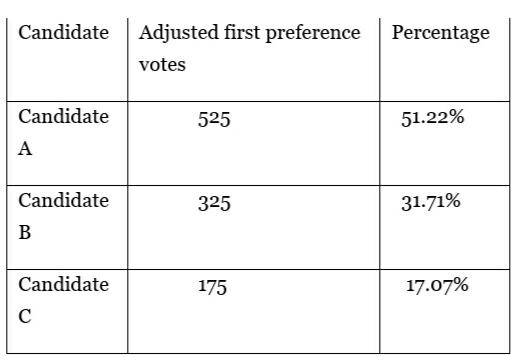Mr. Ram Nath Kovind is the 14th President of India and was elected in the year 2017. The election of Mr. Kovind is special not only because he is the second Dalit president of India but also because he is the first president to be elected by the method of Ranked Choice Method (RCV) in India.
Ranked Choice Voting is a popular electoral system that allows voters to rank candidates by their preference on their ballots, which means they can submit ballots that list not only their first-choice candidate but also their second, third and so on. It is used by the US organization Fair Vote to refer to the use of ranked ballots with specific counting methods either instant-runoff voting for single winner elections which is used in Australian state and federal elections, or single transferable vote for multi-winner elections which is used for national elections in Ireland and Malta.
HOW IT WORKS
Assume that there are four candidates for Chief Minister in Delhi. The table below presents the first-preference vote totals for each candidate.

In the above example, no candidate won an outright majority of first-preference votes. As a result, the candidate D with the smallest number of first preference votes is eliminated. The ballots that listed candidate D as the first preference are adjusted, raising their second-preference candidates. Assume that of the 75 first preference votes for candidate D ,50 listed candidate A as their second preference and 25 listed candidate B. The adjusted vote totals would be as follows:

On the second tally, Candidate A secured 51.22 percent of the vote, thereby winning the election.
RCV ensures that the winner has the majority of voters by taking into account their preferences, apart from the first choice. It could also streamline the election process, making it less expensive, more efficient and fair. While the RCV system makes the process of determining a winner more complicated, the most important advantage of this approach, according to its proponents, is that it leads to better results. It can lead to less negative campaigning. Less divisive political environments can also have the effect of helping female, minority, centrist and third-party candidates.
Also, the opponents of this system contend that it is not a democratic approach and that it won’t solve election problems. RCV advocates argue that plurality system doesn’t always reflect the true will of people. It can lead to vote-splitting among candidates with similar positions, resulting in a candidate who is less popular overall being elected. There is also a fear that ranked choice voting can be used by interested parties to game the system.
Indian democracy is often marred by corruption, scams and political fights which lead to frustration among the Indian voters, This disaffection and frustration is largely to blame for the fact that we have too many elections being decided by too few people—a consequence of low turnout, and of a system that allows for a candidate to sail by without even convincing a majority of those who decide to cast a ballot
India’s is the world largest democracy and we have to set an example for why RCV is an important first step to empowering voters; by giving them more choice and more representation in elections.
By Ridhi
